If you live in Florida and love salamanders, you’re indeed fortunate because there are plenty of different salamander species in this region. In fact, there have been recordings of at least 33 different salamander species in the state of Florida.
Some of these salamanders are semi-aquatic (they live both on land and in the water), some fully terrestrial (they live entirely on land), and some fully aquatic (they live entirely in the water).
Many of these salamanders are most active in the spring, so that is when you are most likely to encounter them. Since there are so many salamander species, the exact size and coloration varies between species
Native Salamanders of Florida
As earlier mentioned, Florida is home to at least 33 salamander species, some species more common than others.
Most of these salamanders are found in the northern part of the state, but some can also be found in the central and southern regions.
If you ever spot a salamander in Florida, It’s probably one of these. You can potentially see salamanders of any age or gender!
1. Southeastern Slimy Salamander
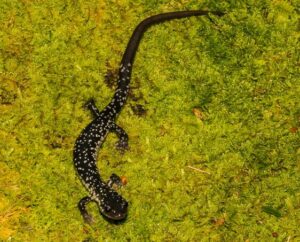
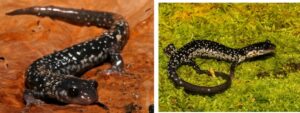
| Scientific Name | Plethodon grobmani |
| Average Adult Size (Length) | 4 – 7 inches |
| Average Lifespan (Years) | 15 – 20 |
Southeastern Slimy Salamanders are fairly large salamanders reaching about 4 to 7 inches in length. Like other slimy salamanders, this species has a black to bluish-black coloration with widely scattered white or brassy flecks.
This flecking pattern varies among individuals and may occasionally merge to create a white, highly mottled pattern along the sides of the body. The belly is typically colored a uniform black.
Slimy salamanders get their name from the very sticky mildly toxic goo they secrete when threatened. This goo sticks to the predator’s mouth enabling the salamander to escape.
Southeastern slimy salamanders are found throughout much of Florida, except for the southern parts of the state.
2. Frosted Flatwoods Salamander


| Scientific Name | Ambystoma cingulatum |
| Average Adult Size (Length) | 3.5 – 5.3 inches |
| Average Lifespan (Years) | Unknown, but estimated to be 15 – 20 |
Frosted flatwoods salamanders have a long, slender build and range about 3.5 to 5.3 inches in length. They have relatively short, pointed snouts and stout tails – and their heads are small and approximately equal in width to the neck and shoulder region
These salamanders have a silvery-gray or black coloration, with light gray or grayish-brown spots/markings that form a frosted lichenlike pattern (hence the name “Frosted Flatwoods salamander”).
Frosted flatwoods salamanders can be found throughout the Atlantic and Gulf Coastal Plains of southern Alabama, Georgia, and South Carolina where they inhabit pine Flatwoods. In Florida, they are only found in the northern parts of the state.
3. Reticulated Flatwoods Salamander

| Scientific Name | Ambystoma bishopi |
| Average Adult Size (Length) | 3.5 – 5.3 inches |
| Average Lifespan (Years) | Unknown, but estimated to be 15 – 20 |
As their name suggests, reticulated flatwoods salamanders are extremely closely related to frosted flatwoods salamanders. In fact, these two salamanders are nearly identical.
The main way these two species can be distinguished is;
- The reticulated flatwoods salamander tends to have shorter limbs and a smaller head than the frosted flatwoods salamander.
- The reticulated salamander’s spots/markings are distinct and well defined while the frosted salamander’s spots/markings are muddled.
This difference in marking gives the reticulated flatwoods salamander a more net-like, or reticulated color pattern than the frosted patterning on the frosted flatwoods salamander.
In Florida, reticulated flatwoods salamanders can be found in the counties west of the Apalachicola River.
4. Marbled Salamander


| Scientific Name | Ambystoma opacum |
| Average Adult Size (Length) | 3 – 5 inches |
| Average Lifespan (Years) | 8 – 10 |
Marbled salamanders are fairly small, only growing 3 to 5 inches in length. They have a dark gray to black coloration with silvery crossbands running along with their chunky bodies. Because of this appearance, they are sometimes called “banded salamanders“.
Male marbled salamanders are typically smaller than females and have whitish crossbands that become very white in the breeding season.
In Florida, marbled Salamanders are only found in the northern parts of the state.
5. Mole Salamander

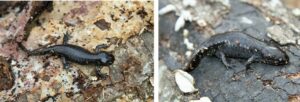
| Scientific Name | Ambystoma talpoideum |
| Average Adult Size (Length) | 3 – 4 inches |
| Average Lifespan (Years) | 10 – 20 |
Mole salamanders are stout-bodied salamanders that grow 3 to 4 inches in length. They have short bodies and large, flattened heads that may look somewhat disproportional to the rest of their body.
Mole salamanders typically have a gray or dark brown coloration with pale bluish or silvery mottling and light gray undersides.
In Florida, mole salamanders can only be found in the northern and mid-central parts of the state.
6. Eastern Tiger Salamander
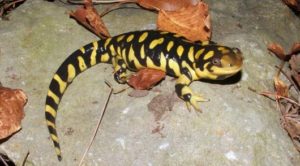
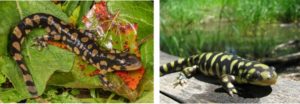
| Scientific Name | Ambystoma tigrinum |
| Average Adult Size (Length) | 6 – 9 inches |
| Average Lifespan (Years) | 15 – 25 |
Eastern tiger salamanders typically range from 6 to 9 inches but can grow up to 13 inches, which makes them the largest terrestrial salamanders in Florida, and one of the largest terrestrial salamanders in North America.
These salamanders can be easily identified by their dull brown coloration, with olive-yellow to brownish-yellow irregular markings (“tiger stripes”). The markings can be large spots, stripes, or irregularly shaped spots.
In Florida, eastern tiger salamanders are found mainly in the panhandle.
7. Southern Red Salamander

| Scientific Name | Pseudotriton ruber vioscai |
| Average Adult Size (Length) | 5 – 6 inches |
| Average Lifespan (Years) | 15 – 20 |
Southern red salamanders grow about 5 to 6 inches in length and have an orange-red to brown coloration with numerous bold black spots on the back and sides.
The head and mouth region has white flecking – and the underside has dark spots beneath hind limbs.
Older southern red salamanders are typically darker and the spots become less defined, giving them a purple-brown coloration.
These salamanders have short tails and have 16 grooves along their body. Like many salamanders, females are larger than males.
Red salamanders are found in the eastern United States, from Alabama to northern New York. In Florida, they are limited to the panhandle.
8. Rusty Mud Salamander

| Scientific Name | Pseudotriton montanus floridanus |
| Average Adult Size (Length) | 3 – 5 inches |
| Average Lifespan (Years) | 15 – 20 |
Rusty mud salamanders grow between 3 and 5 inches in length. They have a reddish-brown coloration with well-black spots which makes them look very similar to red salamanders.
However, there are several ways you can tell these two salamanders apart.
- The red salamander has spots that are irregularly shaped and frequently overlap. In contrast, the mud salamander has fewer spots that are well separated from one another and do not overlap.
- The red salamander has a golden/Yellow iris. In contrast, the Iris of the mud salamander is solid black/brown color.
- The red salamander has long snout. In contrast, the snout of the mud salamander is shorter and blunter.
Like red salamanders, older mud salamanders may have darker coloration and fused less defined spots.
Rusty mud salamanders have a special connection to Florida because they were a new subspecies of Mud Salamander first found in the state.
They are distributed across the northern part of the state of Florida where they are often found in muddy habitats such as springs or ponds.
9. Gulf Coast Mud Salamander
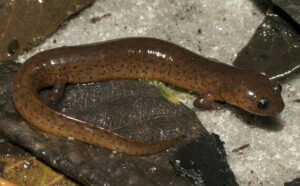
| Scientific Name | Pseudotriton montanus flavissimus |
| Average Adult Size (Length) | 3 – 5 inches |
| Average Adult Size (Length) | 15 – 20 |
As its name suggests, this is a subspecies of mud salamander and is very closely related to the rusty mud Salamander. Like the rusty mud salamander, gulf coast mud salamanders grow 3 to 5 inches in length and have reddish-brown small dark spots. Coloration darkens with age and the spots become less defined.
The main difference between rusty mud salamanders and gulf coast mud salamanders is that the latter tends to have a more slender build. Apart from this, these two subspecies are nearly identical and can be difficult to tell apart.
Gulf coast mud salamanders can be found in northern Florida and the panhandle along slow-flowing creeks or other muddy habitats.
10. Four-Toed Salamander


| Scientific Name | Hemidactylium scutatum |
| Average Adult Size | 2 – 4 inches |
| Average Lifespan (Years) | Unknown, but estimated to be 8 – 12 |
Four-toed salamanders range from 2 to 4 inches in length. They get their name from the four toes on both their front and hind feet. (Most salamanders have five toes on the back feet, and four on the front feet).
Four-toed salamanders have a reddish-brown or gray-brown coloration on the back, with gray sides and a white belly with black spots.
These salamanders also have an obvious constriction at the base of the tail where it can detach if grabbed by a predator, allowing the salamander to escape.
In Florida, four-toed salamanders are only found in limited areas of the panhandle, mostly in Leon, Jefferson, and Walton Counties.
11. Three-Lined Salamander
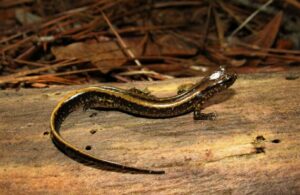
| Scientific Name | Eurycea guttolineata |
| Average Adult Size (Length) | 4 – 6.5 inches |
| Average Lifespan (Years) | Unknown, but estimated to be 12 – 20 |
Three lined salamanders are mid-sized, slender salamanders that grow between 4 and 6.5 inches in length. Their tail is very long and accounts for approximately 65% of the total body length.
Three-lined salamanders have a tan to light yellow coloration with a black stripe along the spine to the base of the tail and a black stripe running along either side of the body down to the tail (hence the name, “three-lined salamander”).
In some individuals, the central stripe may not be continuous and may appear as a series of dark bars with small spaces between them.
In Florida, three-lined salamanders are only found in the panhandle.
12. Southern Two-Lined Salamander
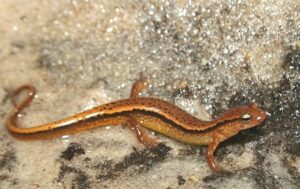

| Scientific Name | Eurycea cirrigera |
| Average Adult Size (Length) | 2 – 4 inches |
| Average Lifespan (Years) | Unknown, but estimated to be 5 – 10 |
Southern two-lined salamanders are on the small side, only growing between 2 to 4 inches in length. You easily identify them by their greenish-yellow or orange back with two parallel dark brown or black lines running from their eyes to their tail.
Male two-lined salamanders have small projections from the nostrils that point downwards. These projections are thought to help them in chemoreception.
In Florida, southern two-lined salamanders are found across much of the panhandle, and limited areas of the northern part of the state.
13. Southern Dusky Salamander
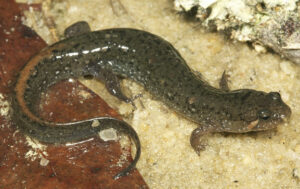
| Scientific Name | Desmognathus auriculatus |
| Average Lifespan (Years) | 3 – 5 inches |
| Average Adult Size (Length) | 10 -15 |
Southern dusky salamanders are fairly stout and grow between 3 to 5 inches in length.
Their coloration is highly variable, but they are generally dark brown to black with a row of white spots running down the sides of the body and tail. The underside is scattered with distinct white spots.
As in all dusky salamander species, a pale line runs diagonally from each eye to the base of the jaw, and their back legs are visibly larger than the front.
Southern dusky salamanders are distributed across the north and central regions of the state.
14. Spotted Dusky Salamander
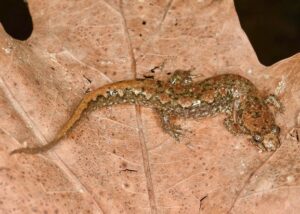
| Scientific Name | Desmognathus conanti |
| Average Adult Size (Length) | 3 – 5 inches |
| Average Lifespan (Years) | 10 – 15 |
As the name suggests, spotted dusky salamanders are a subspecies of dusky salamander and are very closely related to the Southern Dusky.
Like the southern dusky, spotted dusky salamanders grow between 3 and 5 inches in length – and their back legs are noticeably larger than the front.
They have a variable coloration but are generally tan to brown to nearly black, with 6 to 8 pairs of golden or reddish dorsal spots, which are normally separated (hence the name “spotted dusky salamander”). In adults, these spots may form a light stripe with a dark, irregular border.
In Florida, spotted dusky salamanders can only be found in the western region of the panhandle and in Marion and Polk Counties.
15. Apalachicola Dusky Salamander

| Scientific Name | Desmognathus apalachicolae |
| Average Adult Size (Length) | 3 – 5 inches |
| Average Lifespan (Years) | 10 – 15 |
Like other dusky salamander species, Apalachicola dusky Salamanders grow between 3 and 5 inches in length – and their back legs are noticeably larger than the front.
Although their coloration is highly variable, they are generally brownish to gray and have 5 to 7 pairs of light, rounded, dark-edged blotches on the back. These blotches may sometimes be fused – and older males may have a uniform brown coloration.
Apalachicola dusky salamander can be hard to distinguish from other dusky salamander species. The main way you can distinguish them is by their range.
In Florida, these salamanders are restricted to a few river drainages of the Apalachicola region, specifically streams that are tributaries of the Apalachicola/Chipola and Ochlockonee rivers.
16. Seal Salamander

| Scientific Name | Desmognathus monticola |
| Average Adult Size (Length) | 3 – 5 inches |
| Average Lifespan (Years) | 10 – 15 |
The seal salamander is one of a group of species called “stream salamanders”. They get their name from the “seal-like” posture they hold when alert.
These salamanders grow between 3 and 5 inches in length, with the tail comprising about half the total length of the body.
Seal salamanders have an extremely variable coloration. However, they generally have a mottled back, usually dark brown to black on a gray or light brown background.
The belly is light gray to white, with gray or light brown markings. Some individuals may also have a single row of white dots on the sides and legs.
Seal salamanders are very secretive and rarely stray from the water, so they are not frequently encountered.
In Florida, seal salamanders are only found in the far western tip of the panhandle.
17. Southeastern Dwarf Salamander

| Scientific Name | Eurycea quadridigitata |
| Average Adult Size (Length) | 2 – 3.5 inches |
| Average Lifespan (Years) | Unknown, but estimated to be 5 – 10 |
True to the name, dwarf salamanders are one of the smallest salamanders in North America. Full-grown adults typically grow between 2 and 3.5 inches in length and may weigh less than a gram.
Southeastern dwarf salamanders typically have a yellow-brown coloration with darker brown blotching and dark stripes down each side. This coloration makes them look like tiny southern two-lined salamanders.
The main way you call tell these two species apart is by looking at the legs.
- Dwarf salamanders have only four toes on each of their back feet
- Whereas two-lined salamanders have five toes on their back feet (as do most other salamanders).
In Florida, southeastern dwarf salamanders can be found in the north and north-central parts of the state, around Lake Okeechobee, and in Pinellas, Sarasota, and Dade Counties.
18. Striped Newt
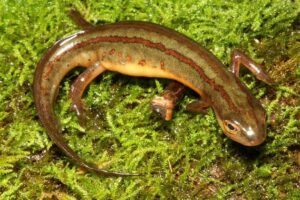
| Scientific Name | Notophthalmus perstriatus |
| Average Adult Size (Length) | 2 – 4 inches |
| Average Lifespan (Years) | 12 -15 |
Striped newts are fairly small, only growing about 2 to 4 inches in length.
Adult striped newts have an olive green to black-brown coloration with bright red parallel dorsal stripes and a yellowish underside with black spots. The belly is lighter colored than the back and sides and is usually a yellow or orange color with black spots.
In the juvenile stage of life, stripped newts (known as efts) have a dull orange coloration with two red stripes on their backs. Their tail is also more rounded than that of the adults.

Striped newts are found only in northern Florida and southern Georgia
19. Central Newt
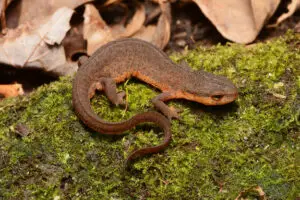
| Scientific Name | Notophthalmus viridescens louisianensis |
| Average Adult Size (Length) | 2 – 4 inches |
| Average Lifespan (Years) | 12 -15 |
Central newts grow between 2 and 4 inches in length and have an olive-brown coloration with fine black dots all over the body. Some individuals may have very small red spots bordered with black along the back on both sides of the spine.
The underside is a bright orange-yellow and is noticeably lighter than the rest of the body.
Like the striped newt, juvenile central newts look different from adults. They generally have a dull brown to reddish-brown color.
In Florida, central newts are found the northern parts of the state.
20. Peninsula Newt
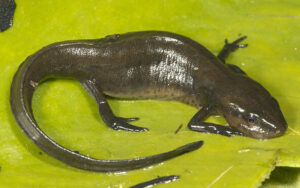
| Scientific Name | Notophthalmus viridescens piaropicola |
| Average Adult Size (Length) | 2 – 4 inches |
| Average Lifespan (Years) | 12 – 15 |
Peninsula Newts grow between 2 and 4 inches in length. Having a greenish-brown to almost black coloration, they are generally darker than Florida’s other newt species.
Like the central newt, peninsula newts have fine back dots all over their body. The underside is a deep orange.
These newts can be found among hyacinth roots in freshwater across most of the peninsula.
21. Many-Lined Salamander

| Scientific Name | Stereochilus marginatus |
| Average Adult Size (Length) | 2 – 4 inches |
| Average Lifespan (Years) | Unknown, but estimated to be 5 -10 |
Many-lined salamanders are small (2- 4 inches in length) highly aquatic salamanders. These salamanders have a slender build and a distinctive small head and short tail.
They have a dull brown to yellow coloration with dark longitudinal stripes running down the sides of the body. These stripes may only appear as a series of dark spots in some individuals. The belly is yellow with a few scattered dark spots.
In Florida, many lined salamanders can be found in blackwater streams, ponds, and ditches along the southern edge of the Okefenokee Swamp.
Aquatic Salamanders in Florida
Unlike terrestrial salamanders, aquatic salamanders live entirely in the water, even after transforming into adults. This means they have features that are adapted for life in the water, rather than on land.
Aquatic salamanders have more varied features than terrestrial salamanders. Some aquatic salamanders have 4 legs, but others only have forelegs and lack hind legs. Some have gills, but others do not and largely breathe underwater through their skin.
However, despite their varied features, all aquatic salamanders have flat paddle-like tails which they use to swim in their aquatic environments.
Here are aquatic salamanders found in the state of Florida.
22. Greater Siren
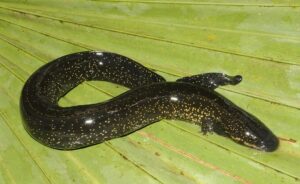
| Scientific Name | Siren lacertina |
| Average Adult Size (Length | 20 – 30 inches |
| Average Lifespan (Years) | 20 – 30 |
Greater sirens typically grow about 20 to 30 inches in length, but some individuals may reach up to 38 inches.
They have an eel-like appearance with a flat paddle-like tail but have external feathery gills that resemble ostrich plumes, and two very small forelegs (sirens do not have hind legs). Each of the forelegs has 4 toes.
These salamanders generally have a grayish-brown or olive-green coloration with dark spots on the head, back and sides. The sides are lighter in color and may have greenish-yellow dashes and blotches – and the underbelly tends to be lighter in color than the skin on the sides.
Greater sirens can be found in calm, hyacinth-covered lakes and slow-moving rivers and canals throughout the entire state of Florida.
23. Eastern Lesser Siren

| Scientific Name | Siren intermedia intermedia |
| Average Adult Size (Length) | 7 – 27 inches |
| Average Lifespan (Years) | 20 – 30 |
Eastern lesser sirens typically range from 7 to 27 inches in length. They have a gray to brown to nearly black coloration with a lighter belly. Individuals with lighter coloration often have small dark spots scattered on the head and back.
The name “lesser” comes from the fact that these sirens are typically smaller than greater sirens; lesser sirens are usually less than 2 feet in total length – in contrast, greater sirens frequently exceed 3 feet in total length.
However, with size difference alone, small greater sirens can easily be mistaken for lesser sirens. The most effective way to tell these two species apart is by counting the number of costal grooves between the armpit and anus.
- Greater sirens typically have 36-40 costal grooves
While,
- Lesser sirens only have 31-35 costal grooves
Eastern lesser sirens can be found in shallow quiet vegetation-covered waters in north Florida and scattered areas in central Florida.
25. Slender Dwarf Siren

| Scientific Name | Pseudobranchus striatus spheniscus |
| Average Adult Size (Length) | 4 – 8 inches |
| Average Lifespan (Years) | Unknown but estimated to be 20 – 30 |
True to the name, dwarf sirens are on the smaller side of the siren salamanders, typically only growing between 4 and 8 inches in length.
Slender dwarf sirens have a narrow head, and a wedge-shaped snout and are slim-bodied. They typically have a brownish-gray coloration with two distinct tan or yellow lateral stripes running along the side of their bodies
The main way you can distinguish dwarf sirens from the greater and lesser siren is by counting the toes on their feet.
- Greater and lesser sirens have four toes on each foot
While
- Dwarf sirens only have three toes on each foot
In Florida, slender dwarf sirens can only be found in the central regions of the panhandle.
26. Narrow-striped Dwarf Siren

| Scientific Name | Pseudobranchus axanthus |
| Average Adult Size (Length) | 4 – 8 inches |
| Average Lifespan (Years) | Unknown but estimated to be 20 – 30 |
Narrow-stripped dwarf sirens measure 4 to 8 inches in length. They have a black, brown, or gray coloration with two narrow yellow or tan stripes on the sides. There are light spots on the belly and a stripe on the underside of the tail.
Like all dwarf sirens, narrow-stripped dwarf sirens only have 3 toes on their feet.
These salamanders are exclusively found in Florida. They are most common in northern Florida, but can also be found
in scattered areas in the central and southern regions of the state.
27. Everglades Dwarf Siren
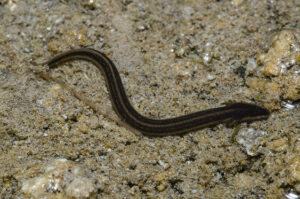
| Scientific Name | Pseudobranchus axanthus belli |
| Average Adult Size (Length) | 4 – 8 inches |
| Average Lifespan (Years) | Unknown but estimated to be 20 – 30 |
The everglades Dwarf Siren is nearly identical to the Narrow-stripped dwarf siren. It typically grows between 4 and 8 inches in length and has a grayish-brown coloration with yellow or tan stripes on the sides.
The most effective way you can tell these two species apart is by counting the number of costal grooves on the sides of their bodies.
- Everglades dwarf sirens typically have 29 to33 costal grooves
While
- Narrow-Striped dwarf sirens have 34 to 37 costal grooves
Like the narrow-stripped siren, everglades dwarf sirens are only found in Florida. They can be found in calm vegetation-covered waters around and south of Lake Okeechobee.
28. Gulf Hammock Dwarf Siren
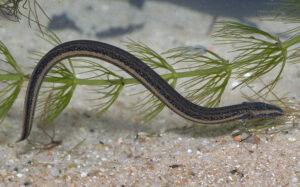
| Scientific Name | Pseudobranchus striatus lustricolus |
| Average Adult Size (Length) | 4 – 8 inches |
| Average Lifespan (Years) | Unknown but estimated to be 20 – 30 |
Gulf Hammock Dwarf Sirens grow about 4 to 8 inches in length and have a stout form. They have a flattened head and blunt snout – and a brownish to gray coloration with a dark, broad stripe running down the back containing three narrow light yellow stripes.
There are two light stripes running along the side of the body, the upper orangish-brown, and the lower silvery-white.
These salamanders are found in the Gulf Hammock region of Florida where they are known only from Levy and Citrus Counties.
29. Broad-striped Dwarf Siren

| Scientific Name | Pseudobranchus striatus striatus |
| Average Adult Size (Length) | 4 – 8 inches |
| Average Lifespan (Years) | Unknown but estimated to be 20 – 30 |
Broad-striped dwarf sirens measure about 4 to 8 inches and have a somewhat stockier build than the other dwarf sirens. They have a brownish to light-gray coloration with a dark brown to blackish middorsal stripe with a narrow yellow line running down the middle.
There have broad yellow longitudinal stripes running along the sides of their body and a light-colored underside that is heavily mottled with yellow.
In Florida, broad-stripped sirens are only found in scattered areas in the northeast part of the state.
30. Western Waterdog
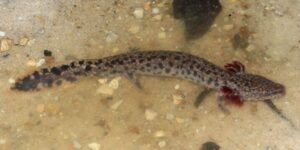
| Scientific Name | Necturus beyeri |
| Average Adult Size (Length) | 6 – 9 inches |
| Average Lifespan (Years) | 10 – 15 |
Western waterdogs were previously known as the “Gulf Coast waterdog“. They grow between 6 and 9 inches in length. Unlike sirens which only have front legs, waterdogs have 4 small well-developed legs (two forelegs and two hind legs).
They use these legs to slowly walk on the bottoms of streams or ponds. The legs can be flattened against the body to give them a more streamlined body during short swimming spurts. Each of their feet has four toes.
Western waterdogs have external gills that look like ostrich plumes on either side of their heads, just where their neck should have been.
Their coloration is generally dark brown but may appear much lighter due to multiple light brown and black speckles that join to form a net-like pattern. Large blackish-blue spots are scattered along the back and sides.
In Florida, western waterdogs can be found in muddy-bottomed streams in the western regions of the panhandle.
31. Georgia Blind Salamander
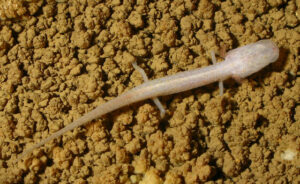
| Scientific Name | Eurycea wallacei |
| Average Adult Size (Length) | 2 – 3 inches |
| Average Lifespan (Years) | Unknown, but estimated to be 10 – 15 |
Georgia blind salamanders are fairly small, measuring only 2 to 3 inches in length. These salamanders are highly adapted to their life in underground water in dark caves; they have no eyes, and very little pigmentation on their body, making them pinkish-white in color, with scattered black spots on the back and sides.
They have a broad flattened head with a snout that is longer than most salamanders, long bright red external gills, a laterally compressed tail, and skinny legs.
In Florida, Georgia blind salamanders are only found in a very small area of the panhandle, where they are known from at least eight locations near Marianna in Jackson County.
32. One-toed Amphiuma
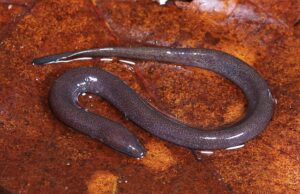
| Scientific Name | Amphiuma pholeter |
| Average Adult Size (Length) | 6 – 12 inches |
| Average Lifespan (Years) | Unknown, but estimated to be 20 – 30. |
One-toed amphiumas are slender eel-like aquatic salamanders that typically grow between 6 and 12 inches in length.
They have four small inconspicuous vestigial legs, one pair just behind each side of the neck and another pair just ahead of the longitudinal anal slit.
However, they don’t use these to walk. When out of the water, they move in a snake-like pattern and use their legs as balancing organs. They get their name from the single toe on each of their legs.
Unlike the sirens and water dogs, amphiumas do not have external gills, but rather have lungs to breathe air from the surface of the water and can breathe underwater through their skin.
In terms of coloration, One-toed amphiumas are typically uniformly gray-black to purplish-brown. Unlike most other salamanders, their underside is the same color as the rest of their body.
One-toed amphiumas have a range that is mostly restricted to the Florida panhandle, mostly around the gulf hammock region, and only barely extending into extreme southern Georgia and southern Alabama.
33. Two-toed Amphiuma
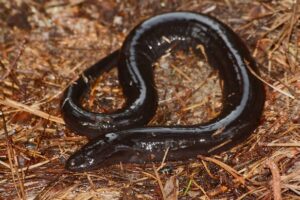
| Scientific Name | Amphiuma means |
| Average Adult Size (Length) | 14 – 45 inches |
| Average Lifespan (Years) | 20 – 30 |
Two-toed amphiumas grow anywhere between 14 and 45 inches in length, which makes them the longest salamanders in North America, and one of the longest in the world.
Like the one-toed amphiuma, two-toed amphiumas have an eel-like appearance with 4 vestigial legs. Each of their legs has two toes, hence their name.
They do not have external gills, and instead use their lungs to breathe air from the surface of the water, and breathe underwater through their skin.
Their coloration is a uniform brown or dark gray to almost black with a light gray color on their belly that extends onto the sides.
Two-toed amphiumas can be found in slow-moving freshwater throughout the entire state of Florida
Florida’s “Newest” Salamanders
In 2018, a team of researchers discovered a new species of salamander living in Alabama and the Panhandle region of Florida. They named this new species the “reticulated siren” (Siren reticulata).

The first known reticulated siren was collected in 1970, in Baldwin County, Alabama. However, it was not formally named at the time, and was informally referred to as the “leopard eel”.
It took researchers about 5 years searching ponds and other water bodies in the Florida panhandle before they could find enough specimens to formally describe the “new” species.
The reticulated siren is genetically distinct from all currently-recognized species of sirens. They can grow up to 24 inches in length, and have two small forelegs, like other sirens.
Their coloration is generally greenish-gray with a patchwork of dark, leopard-like spots covering the back. The underside is a light yellowish-green.
Currently, reticulated sirens are only known from three locations:
- A freshwater marsh near Lake Jackson – on the border between Florida and Alabama
- A clearwater stream on Eglin Air Force Base, Okaloosa County, Florida
- A blackwater stream in Baldwin County, Alabama
New Waterdog Species
In 2020, the Apalachicola waterdog (Necturus moleri) and the Escambia waterdog (Necturus mounti) were split from the western waterdog.
Previously, they were all grouped together as the “Gulf Coast waterdog“, however genetic studies found enough genetic divergence for them to be considered different species.
Both of these species can be found in the western region of the panhandle where they share most of their range.
Final Thoughts
Florida has over 30 salamander species, with some being more widely distributed and more common their others.
Some species, particularly a few waterdog species, have not yet been formally described and named by science so there is very little reliable scientific information about them.
These interesting amphibians are all over Florida, and you’re sure to catch sight of one if you take the time to look, especially in the months when they are most active.


